Last-Minute NYC Holiday Gift Guide 🎁
We’ve created a holiday gift guide with presents for the intrepid New Yorker that should arrive just in time—


![]() Welcome to the creative universe of Ferran Adrià (photo courtesy of Palau Robert, Barcelona).
Welcome to the creative universe of Ferran Adrià (photo courtesy of Palau Robert, Barcelona).
The “Ferran Adrià and elBulli. Risk, Freedom and Creativity” exhibition unveils the creative universe and talent of Ferran Adrià , the late 20th and early 21st centuries’ most influential chef, as well as the comprehensive capacity to innovate that he has applied to gastronomy with his work at elBulli restaurant. The exhibition is open to the public from February 2, 2012 to February 3, 2013 in room 3 at the Palau Robert in Barcelona.
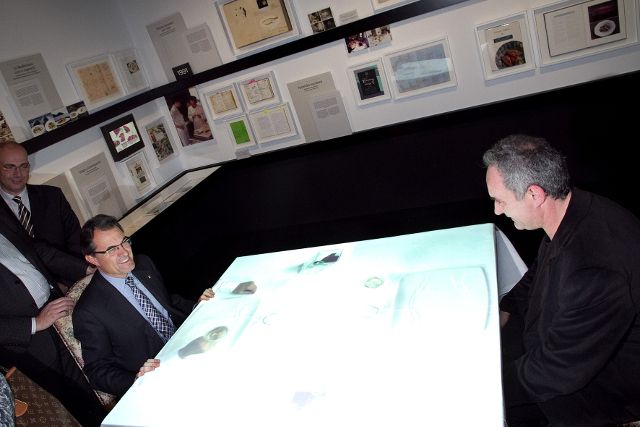 Ferran Adrià (on the right) visiting the exhibition, seated at the projection table (photo courtesy of Palau Robert, Barcelona).
Ferran Adrià (on the right) visiting the exhibition, seated at the projection table (photo courtesy of Palau Robert, Barcelona).
Over the years, Ferran Adrià has become a global icon of gastronomy. The work done at elBulli – considered the world’s best restaurant for five years running – has received global recognition and has set the direction for the future of cooking and how we think about food and dining. The names of Ferran Adrià, Juli Soler, Albert Adriàand of elBulli’s entire creative team are associated with values such as reflection, talent, innovation, leadership, teamwork, a job well done, internationalization and solidarity. Going far beyond the field of gastronomy, their work embraces areas such as art and technology.
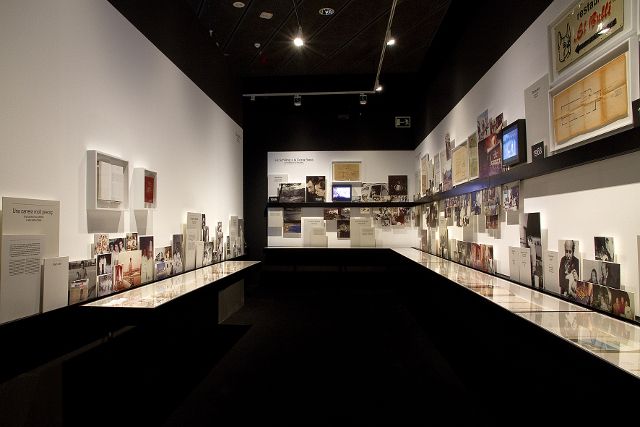 The room “Origins (The Learning Years)” recounts the history of elBulli from its origins in 1956 to March 1987, the time when Ferran Adrià took charge of elBulli as its chef (photo courtesy of Palau Robert, Barcelona).
The room “Origins (The Learning Years)” recounts the history of elBulli from its origins in 1956 to March 1987, the time when Ferran Adrià took charge of elBulli as its chef (photo courtesy of Palau Robert, Barcelona).
The exhibition comes after elBulli closed its doors in July 2011 and celebrates the restaurant’s 50 years of history (from 1961 on), coinciding with a time when Catalan gastronomy has become one of the top-ranking gastronomies in the global arena. Incidentally, Adrià turns 50 in 2012.
Although the decision to close the world-famous 3 Michelin star restaurant was taken in order that it could undergo its transformation (Adrià stated elBulli had completed its journey as a restaurant) into elBulli foundation, a center for gastronomic experimentation and innovation that plans to disseminate its creations on the Internet from 2014 on, critics like to point out the restaurant had been operating at a loss in its later years. Once you enter Adrià’s creative universe at the exhibition, however, it quickly becomes clear that here is a genius who cannot simply go on cooking – he needs to innovate and transcend regular restaurant work.
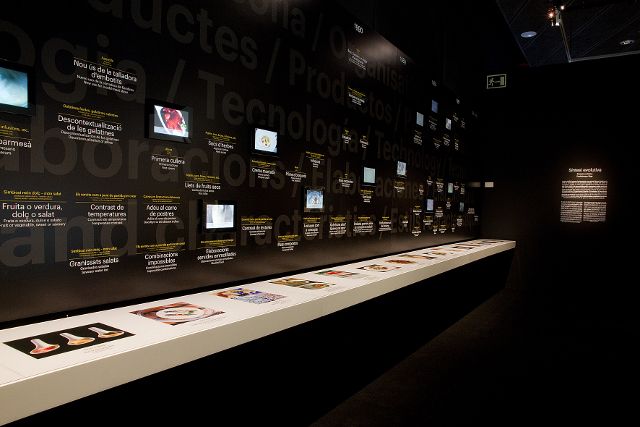 The evolutionary map illustrates the products, techniques, elaborations and philosophy with videoclips, and visitors can see emblematic dishes elaborated, all of which have been major milestones in Ferran Adrià’s career and elBulli’s history (photo courtesy of Palau Robert, Barcelona).
The evolutionary map illustrates the products, techniques, elaborations and philosophy with videoclips, and visitors can see emblematic dishes elaborated, all of which have been major milestones in Ferran Adrià’s career and elBulli’s history (photo courtesy of Palau Robert, Barcelona).
The exhibition recounts the history of elBulli, from its origins in 1956 with the arrival of Dr Schilling and his wife Marketta at Cala Montjoi (between Roses and Cadaques), to March 1987, the time when Ferran Adrià took sole charge of elBulli as its chef. Audiovisuals, documents, photos and objects in chronological order highlight the qualitative jump made by the restaurant through an increasingly sophisticated gastronomic offering that had clear references to French nouvelle cuisine. In addition to Ferran Adrià, the key figures in this transformation were Jean-Louis Neichel, Juli Soler and Albert Adrià .
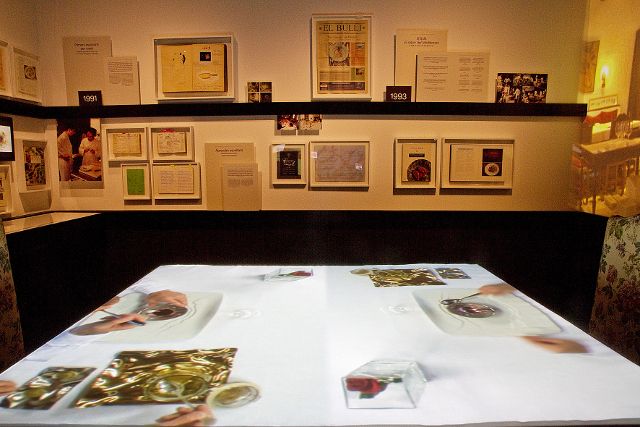 “The Search For A Style” room with a restaurant table where an elBulli 40-dish menu is projected (photo courtesy of Palau Robert, Barcelona).
“The Search For A Style” room with a restaurant table where an elBulli 40-dish menu is projected (photo courtesy of Palau Robert, Barcelona).
One of the highlights is the “The Search For A Style” room where visitors can see a recreation of the atmosphere of the restaurant’s dining room through an audiovisual with props (table and chairs from elBulli): images of an elBulli 40-dish tasting menu are projected onto the table from overhead, allowing visitors to at least visually witness the dining experience. And in general there is great emphasis on how elBulli’s innovative contribution to avant-garde cuisine is the sixth sense: sparking a response in diners, which is expressed in the form of gestures and emotions of surprise, questioning, recollection, desire and happiness. Ferran Adrià creates neither dishes nor recipes, but rather concepts and techniques that he can subsequently apply to countless elaborations, as is explained in the section “Moment 0” of the exhibition.
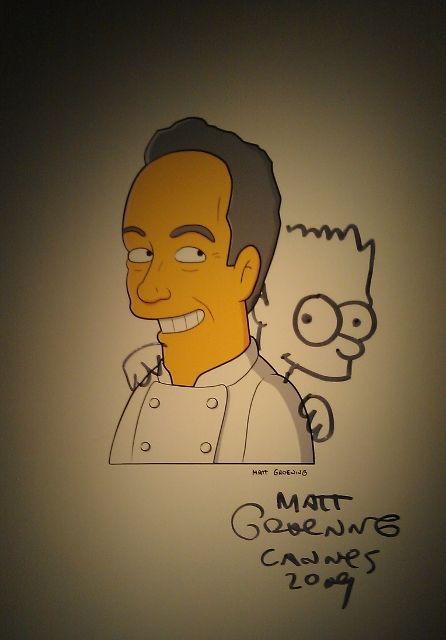 One of the more quirky exhibits: a signed Matt Groening caricature of Adrià (with a scribbled Bart Simpson looking over his shoulder).
One of the more quirky exhibits: a signed Matt Groening caricature of Adrià (with a scribbled Bart Simpson looking over his shoulder).
His technical-conceptual approach to cooking and creating requires a whole team devoted exclusively to creation in an ideal space, and to immense subsequent cataloging; among the exhibits are drawings of dishes done by Ferran Adrià; a display of metal tableware elements used for serving, custom-made silicone molds, objects and utensils used in the cooking process, an array of plasticine dishes used to demonstrate the ideal food layout on a plate, and of course countless cookbooks and notebooks.
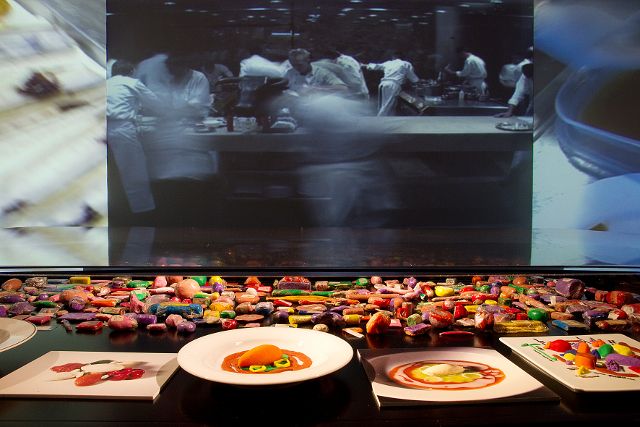 “The Time of Major Change” – A recreation of elBulli’s kitchen through projections in triptych form (photo courtesy of Palau Robert, Barcelona).
“The Time of Major Change” – A recreation of elBulli’s kitchen through projections in triptych form (photo courtesy of Palau Robert, Barcelona).
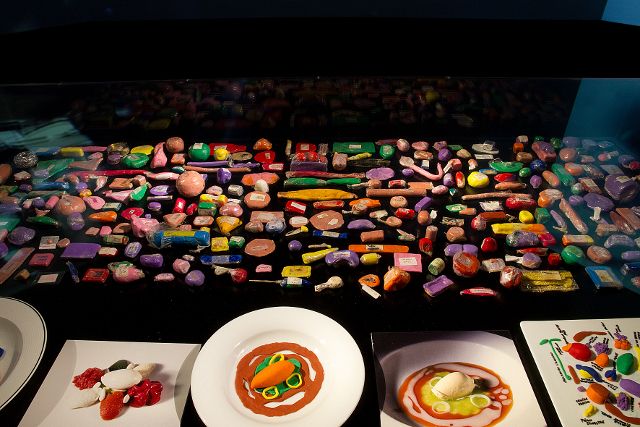 Plasticine ingredients used to demonstrate the ideal layout of a dish (photo courtesy of Palau Robert, Barcelona).
Plasticine ingredients used to demonstrate the ideal layout of a dish (photo courtesy of Palau Robert, Barcelona).
The exhibition will be presented in New York in 2013 and will then travel to London. It will also become the seed or basis for the future Centre-Museum devoted to Ferran Adrià and elBulli in Roses. The aim of these and other initiatives that may subsequently arise is to project the image of Catalonia to the world –showing it as a modern, innovative country – and to position it as a leader and point of reference on the global stage of gastronomy thanks to the enormous amount of research that was carried out at elBullirestaurant and will continue to be carried out at elBullifoundation. The exhibition also deems that Catalonia should officially ask UNESCO to designate Catalan gastronomy as Intangible Cultural Heritage of Humanity, as it did with the castellers (people erecting Human Towers).
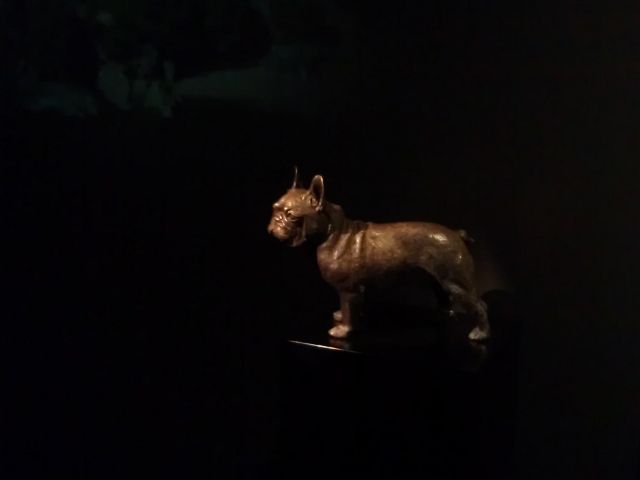 The beginning: a bronze statue of the “Bulli” bulldog that gave the restaurant its name.
The beginning: a bronze statue of the “Bulli” bulldog that gave the restaurant its name.
While it is possible to venture out to Cala Montjoi and the site where elBulli the restaurant is being transformed into elBulli the foundation, you’ll have to head to Barcelona to experience the food: the Adrià brothers run both the tapas bar Tickets on Avinguda Paral ·lel 164 and an avant-garde place next door called 41 ° (41 Grados). Just like at elBulli, getting in is difficult: 41 Grados only takes reservations online and only for an even number of diners, thus keeping out solo critics. They serve “one experience” of 41 mini-courses to a total of 16 people per night. But there is more: Ferran and Albert Adrià are setting up a Mexican restaurant (their first of a different cuisine) and plan on opening a Japanese-influenced Nikkei place, both also in Barcelona. Who knows what’s next? It will remain interesting to watch the Adriàs.
Ferran Adrià and elBulli. Risk, Freedom and Creativity exhibition
The Palau Robert Catalan Information Centre
Passeig de Gràcia, 107 08008 Barcelona [MAP]
(+34) 93 238 80 91 / 92 / 93
Open Monday to Saturday 10am to 8pm. Sunday 10am to 2.30pm. Admission free.
Thanks to the Palau Robert for the pictures and press material.
Get in touch with the author @flachrattenmann.
Subscribe to our newsletter